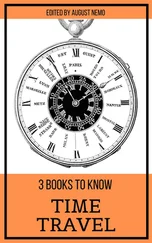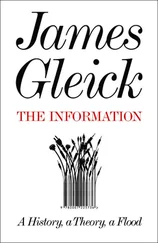James Gleick - Time Travel
Здесь есть возможность читать онлайн «James Gleick - Time Travel» — ознакомительный отрывок электронной книги совершенно бесплатно, а после прочтения отрывка купить полную версию. В некоторых случаях можно слушать аудио, скачать через торрент в формате fb2 и присутствует краткое содержание. Год выпуска: 2016, Издательство: Knopf Doubleday Publishing Group, Жанр: Старинная литература, на английском языке. Описание произведения, (предисловие) а так же отзывы посетителей доступны на портале библиотеки ЛибКат.
- Название:Time Travel
- Автор:
- Издательство:Knopf Doubleday Publishing Group
- Жанр:
- Год:2016
- ISBN:нет данных
- Рейтинг книги:5 / 5. Голосов: 1
-
Избранное:Добавить в избранное
- Отзывы:
-
Ваша оценка:
- 100
- 1
- 2
- 3
- 4
- 5
Time Travel: краткое содержание, описание и аннотация
Предлагаем к чтению аннотацию, описание, краткое содержание или предисловие (зависит от того, что написал сам автор книги «Time Travel»). Если вы не нашли необходимую информацию о книге — напишите в комментариях, мы постараемся отыскать её.
Time Travel — читать онлайн ознакомительный отрывок
Ниже представлен текст книги, разбитый по страницам. Система сохранения места последней прочитанной страницы, позволяет с удобством читать онлайн бесплатно книгу «Time Travel», без необходимости каждый раз заново искать на чём Вы остановились. Поставьте закладку, и сможете в любой момент перейти на страницу, на которой закончили чтение.
Интервал:
Закладка:
The many-worlds interpretation—MWI, to those in the know—is a fantastic piece of make-believe championed by some of the smartest physicists of our time. They are the intellectual heirs of Hugh Everett, if not Borges. “The MWI is the one with all the glamour and publicity,” wrote Philip Ball, the English science writer (ex-physicist), in 2015. “It tells us that we have multiple selves, living other lives in other universes, quite possibly doing all the things that we dream of but will never achieve (or never dare). Who could resist such an idea?” (He can, for one.) The many-worlds champions are like hoarders, unable to throw anything away. There is no such thing as a path not taken. Everything that can happen does happen. All possibilities are realized, if not here, then in another universe. In cosmology universes also abound. Brian Greene has named nine different types of parallel universes: “quilted,” “inflationary,” “brane,” “cyclic,” “landscape,” “quantum,” “holographic,” “simulated,” and “ultimate.” The MWI cannot be demolished by means of logic. It’s too appealing: any argument you can make against it has already been considered and (in their minds) refuted by its distinguished advocates.
To me, the most effective physicists are the ones who retain a degree of modesty about their program. Bohr said, “In our description of nature the purpose is not to disclose the real essence of the phenomena but only to track down, so far as it is possible, relations between the manifold aspects of our experience.” Feynman said, “I have approximate answers and possible beliefs and different degrees of certainty about different things, but I’m not absolutely sure of anything.” Physicists make mathematical models, which are generalizations and simplifications—by definition incomplete, stripped down from the cornucopia of reality. The models expose patterns in the messiness and capitalize upon them. The models themselves are timeless; they exist unchanging. A Cartesian graph plotting time and distance contains its own past and future. The Minkowskian spacetime picture is timeless. The wave function is timeless. These models are ideal, and they are frozen. We can comprehend them within our minds or our computers. The world, on the other hand, remains full of surprises.
William Faulkner said, “The aim of every artist is to arrest motion, which is life, by artificial means and hold it fixed.” Scientists do that, too, and sometimes they forget they are using artificial means. You can say Einstein discovered that the universe is a four-dimensional space-time continuum. But it’s better to say, more modestly, Einstein discovered that we can describe the universe as a four-dimensional space-time continuum and that such a model enables physicists to calculate almost everything, with astounding exactitude, in certain limited domains. Call it spacetime for the convenience of reasoning. Add spacetime to the arsenal of metaphors.
You can say the equations of physics make no distinction between past and future, between forward and backward in time. But if you do, you are averting your gaze from the phenomena dearest to our hearts. *11You leave for another day or another department the puzzles of evolution, memory, consciousness, life itself. Elementary processes may be reversible; complex processes are not. In the world of things, time’s arrow is always flying.
One twenty-first-century theorist who began to challenge the mainstream block-universe view was Lee Smolin, born in New York in 1955, an expert on quantum gravity and a founder of the Perimeter Institute for Theoretical Physics in Canada. For much of his career Smolin held conventional views of time (for a physicist) before, as he saw it, recanting. “I no longer believe that time is unreal,” he declared in 2013. “In fact I have swung to the opposite view: Not only is time real, but nothing we know or experience gets closer to the heart of nature than the reality of time.” The rejection of time is itself a conceit. It is a trick that physicists have played on themselves.
“The fact that it is always some moment in our perception, and that we experience that moment as one of a flow of moments, is not an illusion,” Smolin wrote. Timelessness, eternity, the four-dimensional spacetime loaf—these are the illusions. Timeless laws of nature are like perfect equilateral triangles. They exist, undeniably, but only in our minds.
Everything we experience, every thought, impression, intention, is part of a moment. The world is presented to us as a series of moments. We have no choice about this. No choice about which moment we inhabit now, no choice about whether to go forward or back in time. No choice to jump ahead. No choice about the rate of flow of the moments. In this way, time is completely unlike space. One might object by saying that all events also take place in a particular location. But we have a choice about where we move in space. This is not a small distinction; it shapes the whole of our experience.
Determinists, of course, believe that the choice is an illusion. Smolin was willing to treat the persistence of the illusion as a piece of evidence, not to be dismissed glibly, requiring explanation.
For Smolin, the key to salvaging time turns out to be rethinking the very idea of space. Where does that come from? In a universe empty of matter, would space exist? He argues that time is a fundamental property of nature but space is an emergent property. In other words, it is the same kind of abstraction as “temperature”: apparent, measurable, but actually a consequence of something deeper and invisible. In the case of temperature, the foundation is the microscopic motion of ensembles of molecules. What we feel as temperature is an average of the energy of these moving molecules. So it is with space: “Space, at the quantum-mechanical level, is not fundamental at all but emergent from a deeper order.” (He likewise believes that quantum mechanics itself, with all its puzzles and paradoxes—“cats that are both alive and dead, an infinitude of simultaneously existing universes”—will turn out to be an approximation of a deeper theory.)
For space, the deeper reality is the network of relationships among all the entities that fill it. Things are related to other things; they are connected, and it is the relationships that define space rather than the other way around. This is not a new perspective. It goes back at least to Newton’s great rival Leibniz, who refused to accept the view of time and space as containers in which everything is situated—an absolute background for the universe. He preferred to treat them as relations between objects: “Space is nothing else, but That Order or Relation; and is nothing at all without Bodies, but the Possibility of placing them.” Empty space is not space at all, Leibniz would say, nor would time exist in an empty universe, because time is the measure of change. “I hold space to be something merely relative, as time is,” wrote Leibniz. “Instants, considered without the things, are nothing at all.” With the triumph of the Newtonian program, Leibniz’s view almost faded from view.
To appreciate the network-centered, relational view of space, we need look no further than the connected, digital world. The internet, like the telegraph a century before, is commonly said to “annihilate” space. It does this by making neighbors of the most distant nodes in a network that transcends physical dimension. Instead of six degrees of separation we have billions of degrees of connectedness. As Smolin put it:
We live in a world in which technology has trumped the limitations inherent in living in a low-dimensional space….From a cell-phone perspective, we live in a 2.5 billion–dimensional space, in which very nearly all our fellow humans are our nearest neighbors. The Internet, of course has done the same thing. The space separating us has been dissolved by a network of connections.
Читать дальшеИнтервал:
Закладка:
Похожие книги на «Time Travel»
Представляем Вашему вниманию похожие книги на «Time Travel» списком для выбора. Мы отобрали схожую по названию и смыслу литературу в надежде предоставить читателям больше вариантов отыскать новые, интересные, ещё непрочитанные произведения.
Обсуждение, отзывы о книге «Time Travel» и просто собственные мнения читателей. Оставьте ваши комментарии, напишите, что Вы думаете о произведении, его смысле или главных героях. Укажите что конкретно понравилось, а что нет, и почему Вы так считаете.












